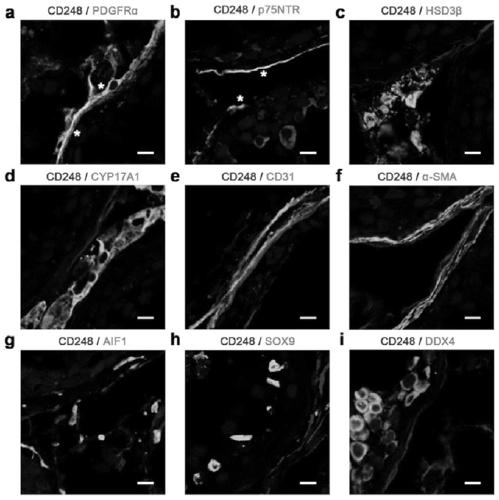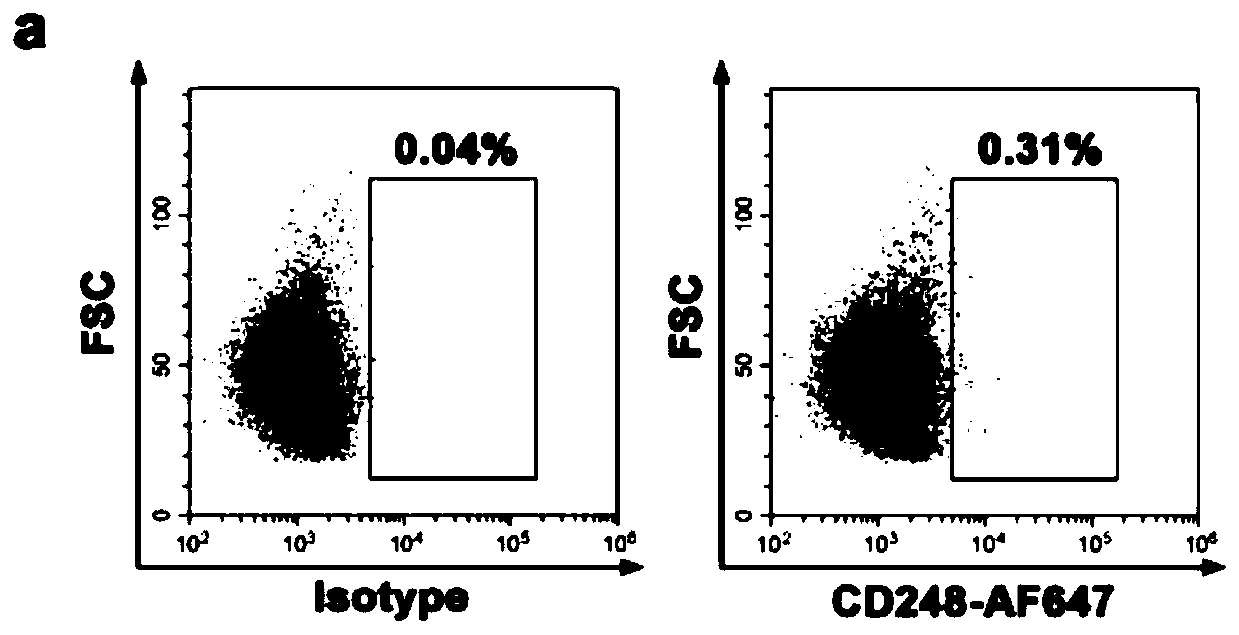Separation and culture method of human testicular mesenchymal stem cells
A Leydig, separation method technology, applied in the field of separation and culture of human Leydig stem cells, can solve the problems of low purity of isolated human SLC, damage to spermatogenesis, increased cardiovascular and cerebrovascular events and prostate cancer risks, etc.
- Summary
- Abstract
- Description
- Claims
- Application Information
AI Technical Summary
Problems solved by technology
Method used
Image
Examples
Embodiment 1
[0044] Example 1 Protein CD248 is specifically expressed in human testicular mesenchymal stem cells (SLC) in human testis tissue
[0045] In this example, we chose to detect the expression of CD248 protein in human testicular tissue (derived from organ donors and deceased patients with prostate cancer), and found that CD248 was specifically expressed in SLC.
[0046] The specific method is as follows:
[0047] 1. Tissue acquisition and preparation:
[0048] Obtain clinically donated testicular tissue, place it in 4% paraformaldehyde solution, and fix it at 4°C for 12 hours; replace it with 30% sucrose solution, and dehydrate it at 4°C for 24 hours; put the tissue block into a frozen section In the embedding medium, place at -20°C for more than 30 minutes, and make sections in a cryostat for subsequent fluorescent staining.
[0049] 2. Immunofluorescence staining and detection:
[0050] The testis tissue slices were baked for 15 minutes, penetrated with 0.2% TritonX-100 for ...
Embodiment 2
[0053] Example 2 Isolation of human testicular mesenchymal stem cells
[0054] In this embodiment, human SLC is isolated from donated human testicular tissue (the source is the same as in Example 1).
[0055] The separation method is as follows:
[0056] 1. Tissue acquisition and digestion:
[0057] Obtain clinically donated testicular tissue specimens, put them into a centrifuge tube containing 5 μg / mL moxifloxacin DMEM / F12 medium, and place them on ice; wash the testicular tissue repeatedly with PBS 3-5 times in an ultra-clean bench. Then use micro scissors to cut the testicular tissue into fine tissue pieces (approximately 1 mm in size) 3 ), then put the shredded testicular tissue into DMEM / F12 digestion solution containing 1 mg / mL type IV collagenase and 200 μg / mL DNase I, and shake slowly on a shaker at 37 °C for 20-30 minutes (100 rpm / minutes), adding phosphate buffered saline (PBS) containing 10% bovine serum albumin (BSA) to terminate the digestion, filtered throug...
Embodiment 3
[0062] The cultivation of embodiment 3 human testicular mesenchymal stem cells
[0063] 1. The culture medium used for the proliferation and cultivation of human testicular mesenchymal stem cells is the formula of testicular mesenchymal stem cell serum-free culture medium for adding the following components to the DMEM / F12 basal medium:
[0064]
[0065]
[0066] 2. Culture method of human testicular mesenchymal stem cells:
[0067] The positive human testicular mesenchymal stem cells collected by the above sorting were incubated with the above culture medium at 37°C and 5% CO 2 Conditions were cultivated, and the culture medium was changed every 3 days. When the cell density reaches 80%, digest with Accutase for 1 min, add culture medium to stop digestion, and centrifuge at 1200 rpm for 4 min.
[0068] After the cell pellet was resuspended in culture medium, the positive human testicular mesenchymal stem cells were 5 Cells / mL were seeded in well plates for culture. ...
PUM
| Property | Measurement | Unit |
|---|---|---|
| Thickness | aaaaa | aaaaa |
Abstract
Description
Claims
Application Information
 Login to View More
Login to View More - R&D
- Intellectual Property
- Life Sciences
- Materials
- Tech Scout
- Unparalleled Data Quality
- Higher Quality Content
- 60% Fewer Hallucinations
Browse by: Latest US Patents, China's latest patents, Technical Efficacy Thesaurus, Application Domain, Technology Topic, Popular Technical Reports.
© 2025 PatSnap. All rights reserved.Legal|Privacy policy|Modern Slavery Act Transparency Statement|Sitemap|About US| Contact US: help@patsnap.com



